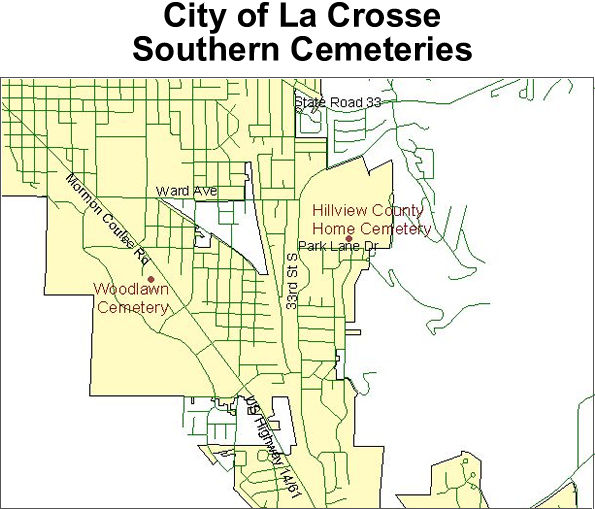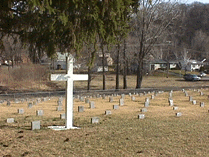Hillview

Located in was once the Town of Shelby, Hillview Health Care Center was originally the City Poor Farm. It was begun soon after the city incorporated in 1856 and was located 4½ miles southeast of the Courthouse. The operation and facilties of the City Poor Farm were turned over to La Crosse County in the 1890's. As is common with governmental institutions, it has a cemetery associated with it.
 In the fall of 1860, Miss Dorothea Dix, described as a militant Massachusetts woman, visited the City Poor Farm with Marcus “Brick” Pomeroy, famous Copperhead editor of the Democratic newspaper in La Crosse. Miss Dix told of the deplorable conditions in the facility, the routine of the poor during their stay, and the questionable ethics of the caretakers. In summary, Pomeroy stated, “The way the house is managed is a disgrace to the city...it was the poorest poor house she [Dix] had seen in five years - and the poorest she had seen in the United States, that we were fairly sick.”
In the fall of 1860, Miss Dorothea Dix, described as a militant Massachusetts woman, visited the City Poor Farm with Marcus “Brick” Pomeroy, famous Copperhead editor of the Democratic newspaper in La Crosse. Miss Dix told of the deplorable conditions in the facility, the routine of the poor during their stay, and the questionable ethics of the caretakers. In summary, Pomeroy stated, “The way the house is managed is a disgrace to the city...it was the poorest poor house she [Dix] had seen in five years - and the poorest she had seen in the United States, that we were fairly sick.”
From approximately 1873-1889, the Poor Farm was in the capable hands of Mr. and Mrs. Frank Metz. City Physicians and Superintendents of Poor praised them and their nursing abilities for over a decade.
According to the History of La Crosse, Wisconsin (1881), the City Poor Farm property of 120 acres in the Town of Shelby was purchased in 1857 at a cost of $6000. The Metz family leased the farm and contracted to “feed and keep the poor who may be sent to them to receive their care and attention at $2.50 per week.” As there was no County Poor House at that time, the County sent its charges to the City Poor Farm, and compensated Mr. & Mrs. Metz 50¢ per day per person.
In 1872, Council directed the City Physician to “visit the City Poor House at least once a week, and report such paupers who are capable to work to Superintendent of Poor, who shall take measures to have such persons discharged from the Poorhouse as promptly as possible.” Superintendents of Poor complained to the Council about the abject condition of the Poor House and Hospital. Around 1894, Superintendent C.F. Scharpf told Council in a report, “I have to call your attention again to the miserable condition of the Poor house[;] thank providence that we have a mild winter or else the old People would freeze.”
The Common Council adopted a resolution in 1893 to contract with La Crosse architects Stoltze and Schick for plans for a proposed poor house. Plans were drawn up, and City Council approved payment of the $125 bill in May 1894. Yet in April of that year, the Council adopted a resolution to sell what now amounted to 80 acres of poor farm property for $4000 to the County Board of Supervisors for “land now owned by the City, situated in the Town of Shelby and known as the city poor farm....” Eventually this property was sold in 1894 or 1895 to the County and became the County Poor House and the County Home & Infirmary.
In 1884, the La Crosse County Board of Supervisors and a Common Council committee met in special session to discuss “the economy and practicability of establishing a county system for the care of the poor and insane.” Although an agreement was not made regarding the county’s poor, decisions were made to establish an institution to care for the county’s mentally challenged residents. Through this City-County cooperation, the groundwork was laid for the “La Crosse County Asylum,” or what is now known as Lakeview Health Care Center, which opened in 1888.
Census List Details:
Search our online cemetery database
